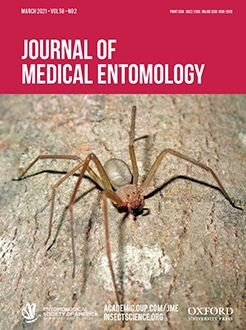The blacklegged tick (Ixodes scapularis Say) is the primary vector of Borrelia burgdorferi sensu stricto (Spirochaetales: Spirochaetaceae), the Lyme disease agent in North America. The basic reproduction number (R0) for B. burgdorferi in I. scapularis in the Northeast is highly sensitive to the probability that engorged larvae survive the winter, molt into nymphs, and find a host. These processes are dependent on local environmental variables, including climate, h-ost population size and movement, and tick behavior. A simple model is presented for estimating host-finding success from the ratio of tick abundance in two subsequent years, accounting for overwinter survival and possible differences in host associations between nymphs and larvae. This model was parameterized using data from two sites in mainland Connecticut and two on Block Island, RI. Host abundance and tick burdens were estimated via mark–recapture trapping of the primary host, Peromyscus leucopus Rafinesque. Overwintering survival was estimated using engorged larvae placed in field enclosures at each site. Only nymphs were recovered alive, and no significant differences in model parameters were observed between Connecticut and Block Island. Host-finding success was predicted to be high across a wide range of host association patterns at three of four sites. Assuming equivalent host association between larvae and nymphs, R0 was also estimated to be greater than one at three of four sites, suggesting these conditions allow for the persistence of B. burgdorferi. The model output was highly sensitive to differences between nymphal and larval host associations.
How to translate text using browser tools
19 November 2020
Ixodes scapularis (Acari: Ixodidae) Nymphal Survival and Host-Finding Success in the Eastern United States
Danielle M. Tufts,
Max McClure,
Maria A. Diuk-Wasser
ACCESS THE FULL ARTICLE
It is not available for individual sale.
This article is only available to subscribers.
It is not available for individual sale.
It is not available for individual sale.

Journal of Medical Entomology
Vol. 58 • No. 2
March 2021
Vol. 58 • No. 2
March 2021
blacklegged tick
Borrelia burgdorferi
Lyme disease
Peromyscus leucopus
white-footed mouse




